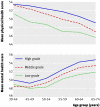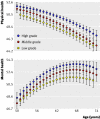Social inequalities in self reported health in early old age: follow-up of prospective cohort study
- PMID: 17468119
- PMCID: PMC1867907
- DOI: 10.1136/bmj.39167.439792.55
Social inequalities in self reported health in early old age: follow-up of prospective cohort study
Abstract
Objective: To describe differences in trajectories of self reported health in an ageing cohort according to occupational grade.
Design: Prospective cohort study of office based British civil servants (1985-2004).
Participants: 10 308 men and women aged 35-55 at baseline, employed in 20 London civil service departments (the Whitehall II study); follow-up was an average of 18 years.
Main outcome measures: Physical component and mental component scores on SR-36 measured on five occasions.
Results: Physical health deteriorated more rapidly with age among men and women from the lower occupational grades. The average gap in physical component scores between a high and low grade civil servant at age 56 was 1.60 and this gap increased by 1 over 20 years. The average physical health of a 70 year old man or woman who was in a high grade position was similar to the physical health of a person from a low grade around eight years younger. In mid-life, this gap was only 4.5 years. Although mental health improved with age, the rate of improvement is slower for men and women in the lower grades.
Conclusions: Social inequalities in self reported health increase in early old age. People from lower occupational grades age faster in terms of a quicker deterioration in physical health compared with people from higher grades. This widening gap suggests that health inequalities will become an increasingly important public health issue, especially as the population ages.
Conflict of interest statement
Figures


Comment in
-
Socioeconomic inequalities in health.BMJ. 2007 May 12;334(7601):963-4. doi: 10.1136/bmj.39203.661829.BE. BMJ. 2007. PMID: 17493985 Free PMC article.
References
-
- Marmot M, Banks J, Blundell R, Lessof C, Nazroo J. Health, wealth and lifestyles of the older population in England: the 2002 English longitudinal study of ageing London: Institute for Fiscal Studies, 2002
-
- Huisman M, Kunst AE, Mackenbach JP. Socioeconomic inequalities in morbidity among the elderly; a European overview. Soc Sci Med 2003;57:861-73. - PubMed
-
- Von Dem KO, Luschen G, Cockerham WC, Siegrist J. Socioeconomic status and health among the aged in the United States and Germany: a comparative cross-sectional study. Soc Sci Med 2003;57:1643-52. - PubMed
-
- House JS, Lepkowski JM, Kinney AM, Mero RP, Kessler RC, Herzog AR. The social stratification of aging and health. J Health Soc Behav 1994;35:213-34. - PubMed
Publication types
MeSH terms
Grants and funding
LinkOut - more resources
Full Text Sources
Molecular Biology Databases
Research Materials
Miscellaneous
